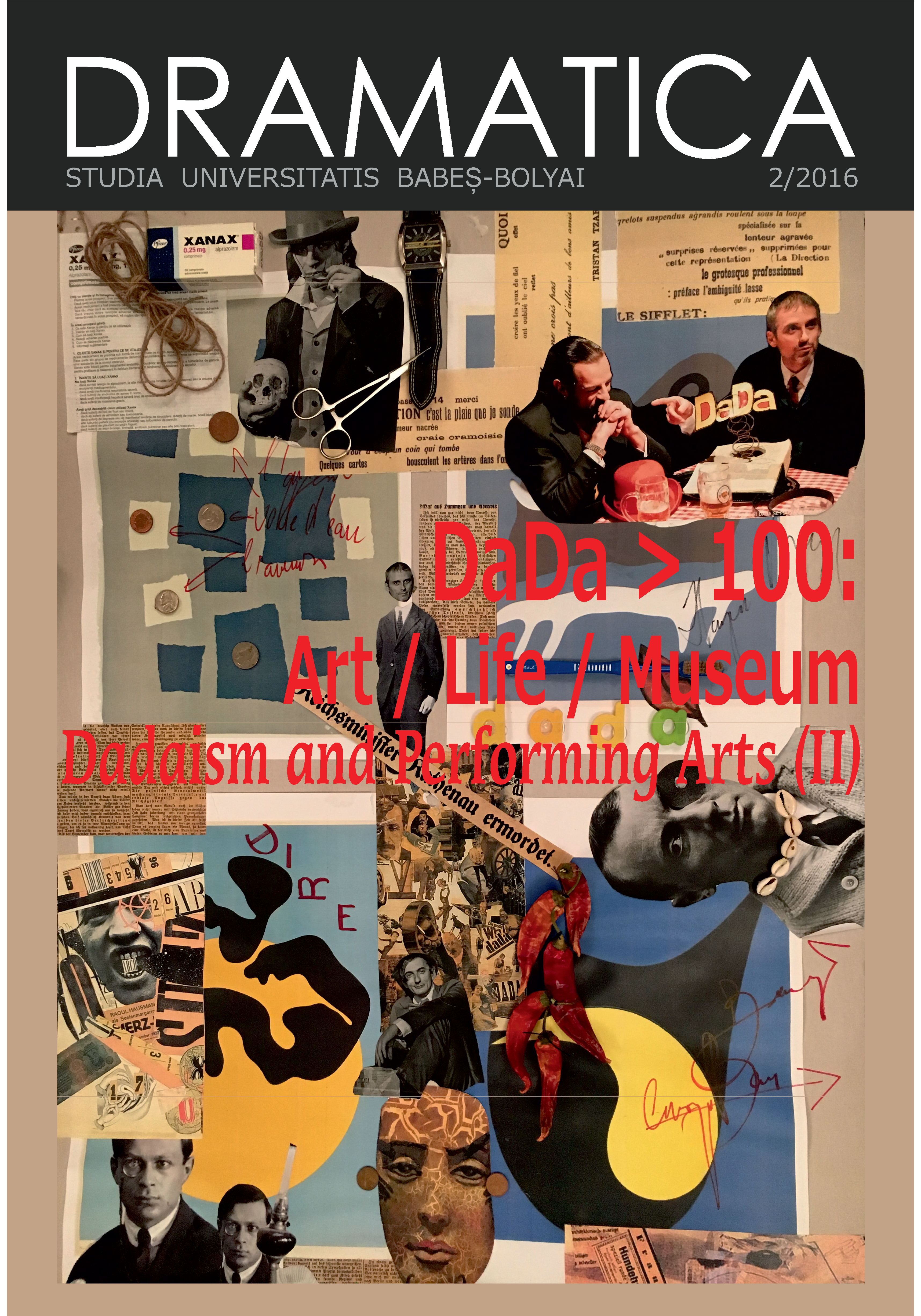Edward Gordon Craig, un dadaïste malgré soi ?
Keywords:
Craig, Dadaism, Futurism, experimental plays.Abstract
Edward Gordon Craig, a Dadaist without Knowing It? Edward Gordon Craig (1872-1966), actor, director and set designer, one of the founders of modern scenography, well known for his radical theory about the replacement of the actor by a mysterious inanimate figure, clothed with “a death-like beauty” and called the Über-marionette, left a legacy of thousands of pages of unpublished manuscripts and drawings that started to be explored by researchers only recently. Some of the manuscripts located in the Craig Collection at the Institut International de la Marionnette are notes and plays for marionettes (finished or unfinished), that Craig intended to gather in a volume under the title The Drama for Fools. A group of French researchers published in 2012 a remarkable bilingual edition of the finished plays and the texts related to them. These texts give us a very different image of Craig, the symbolist who professed the Mystic of Art and yearned for the Ideal Beauty. The article analyses one of these plays, entitled Romeo and Juliet, written in 1918, which is embracing alogical dramatic strategies, similar to those used by the Futurists and the Dadaists. Like them, Craig is appealing to grotesque and absurd, to the carnivalesque reversal of the traditional dramatic categories and conventions, realizing an iconoclastic and parodical rewriting of the canonical text. Our article is trying to point out the similarities between Craig’s aesthetic approach and attitude and those of the Futurists and Dadaists at the same epoch.
References
BABLET Denis, D’Edward Gordon Craig au Bauhaus, in ****Le Masque. Du rite au théâtre. Etudes de O. Aslan, D. Bablet, Cheng Shui Cheng et al. Réunies et présentées par Odette Aslan et Denis Bablet. Paris, CNRS Editions, 1985, pp. 137-146.
BAKHTINE Mikhaïl, Problèmes de la poétique de Dostoïevski, l’édition roumaine : BAHTIN Mihail, Problemele poeticii lui Dostoievski, În românește de S. Recevschi, București, Univers, 1970.
BÉHAR Henri, Étude sur le théâtre DADA et surréaliste, Gallimard, 1967.
****The Correspondance of Edward Gordon Craig and Count Harry Kessler. 1903-1937, Edited by L.M. Newman. Published by W.S.Maney& Son Ltd. For the Modern Humanities Research Association and the Institute of Germanic studies, University of London, 1995.
CRAIG Edward Gordon, De l’art du théâtre, Paris, Editions O. Lieutier, 1942.
CRAIG Edward Gordon, Romeo and Juliet/ Roméo et Juliette, in Puck, nr. 1, 1988, pp. 11-15.
CRAIG Edward Gordon, Le Théâtre des fous. The Drama for Fools. Édition bilingue établie par Didier Plassard, Marion Chénetier-Alev et Marc Duvilier à partir des manuscrits de la collection Edward Gordon Craig de l’Institut International de la Marionnette. Illustrations: Edward Gordon Craig. Traduction française: Marion Chénetier-Alev. Responsable scientifique: Didier Plassard. Coédition L’Entretemps/ Institut International de la Marionnette, Montpellier/ Charleville-Mézières, 2012.
LISTA Giovanni, DADA libertin&libertaire, Paris, l’insolite, 2005.
MAETERLINCK Maurice, Menus propos. Le Théâtre. Un théâtre d’androïdes, in Introduction à une psychologies des songes et autres écrits, Bruxelles, Éd. Labor, 1985.
MIMOSO-RUIZ Duarte, Théâtre et cinéma dans l’œuvre de Luis Buñuel: d’Hamlet (1927) à L’Âge d’Or (1930), in Théâtre et cinémaannées vingt. Tome II, Lausanne, L’Âge d’Homme, 1990, pp. 52-61.
TAXIDOU Olga, The Mask. A Periodical Performance by Edward Gordon Craig. Amsterdam, Harwood Academic Publishers, 1998.
**** Théâtre futuriste italien. Anthologie critique par Giovanni Lista, tome I, Lausanne, La Cité – L’Âge d’Homme, 1976.
Sitographie
http://zeteojournal.com/wp-content/uploads/2016/03/Tristan-Tzara-Dada-manifeste-sur-lamour-faible-et-lamour-amer.pdf (consulté le 13 mai 2016)
http://archives-dada.tumblr.com/post/15903653239/tristan-tzara-comment-je-suis-devenu-charmant(cosulté le 13 mai 2016)
http://bottegaelefante.blogspot.ro/2014/08/un-altro-futurismo-umberto-boccioni-e.html (consulté le 24 septembre 2016).
http://jclandry.free.fr/Artaud/Artaud.htm (consulté le 13 mai 2016)
https://en.wikipedia.org/wiki/Edmund_Kean (consulté le 14 juillet 2015).
Downloads
Published
How to Cite
Issue
Section
License
Copyright (c) 2016 Studia Universitatis Babeș-Bolyai Dramatica

This work is licensed under a Creative Commons Attribution-NonCommercial-NoDerivatives 4.0 International License.


